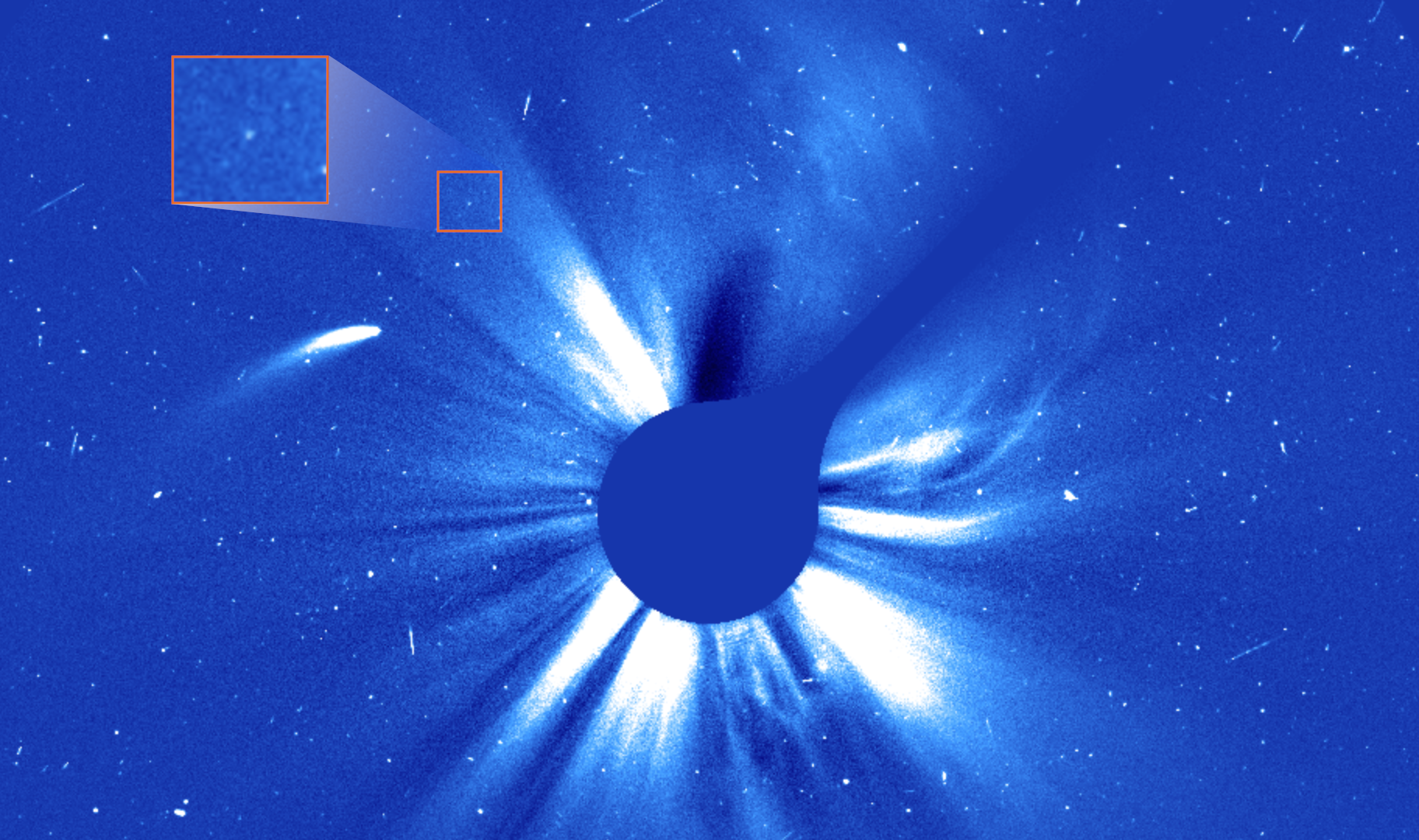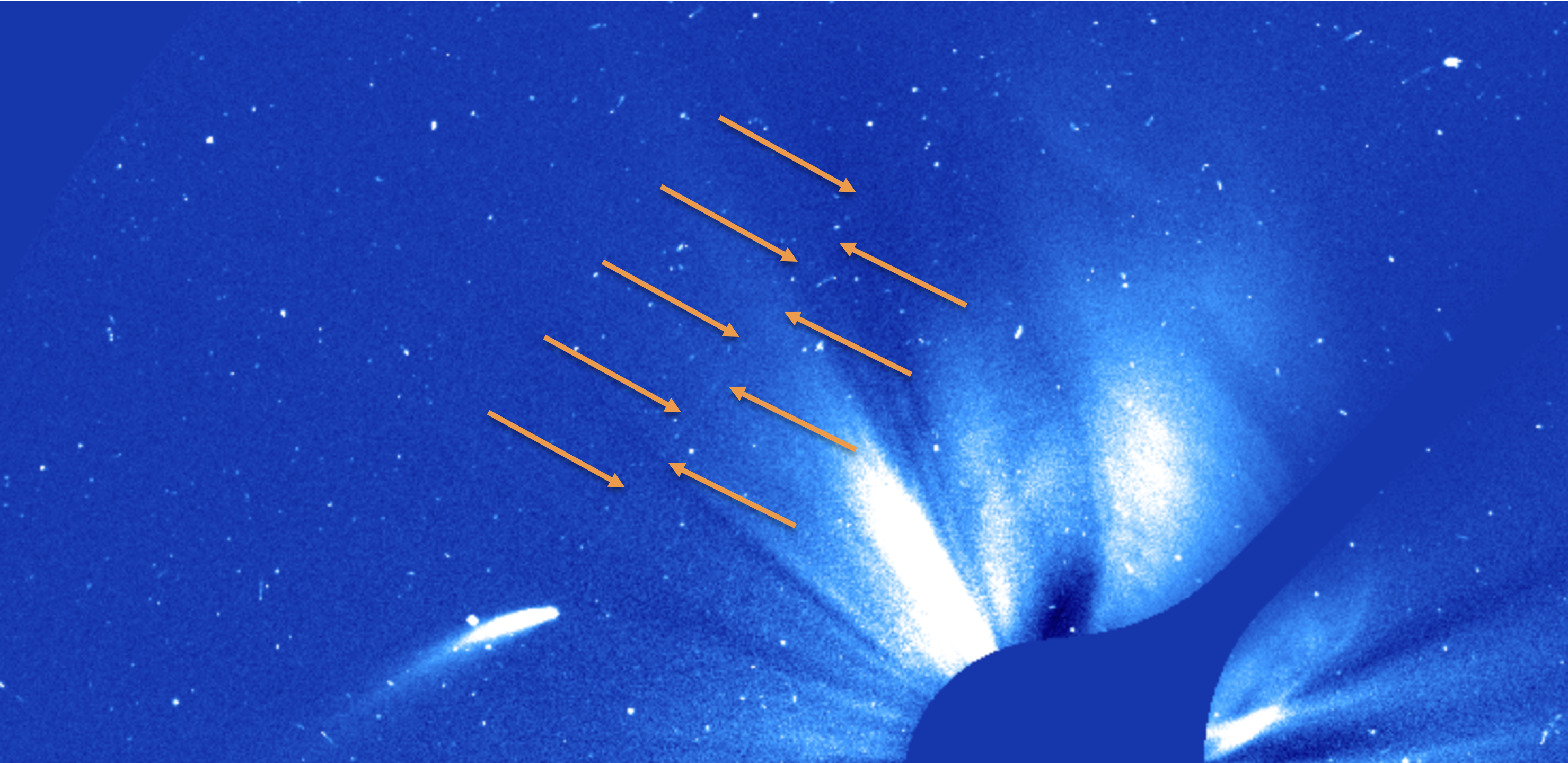96P Machholz Leaves a Lasting Impression
Note: this story is a mirror of the story posted to the main SOHO website as a HotShot feature.
Between January 29 and February 02, 2023, SOHO's old friend - comet 96P/Machholz - returned to the LASCO C3 field of view for the sixth time in the mission's history as it follows its 5.3 year orbit around the Sun. To recognize this rare opportunity, SOHO took a break from its regularly scheduled observations to take some unique science observations that have proven extremely... illuminating!
96P is a near-Sun comet that is surrounded by intrigue. Ground-based studies have shown it to have a very unusual composition1 compared to most periodic comets we see in our solar system. It is also believed to be related to the Arietid and Southern Delta Aquariid meteorid streams that Earth passes through every year, as well as the probable distant parent to the "Kracht" and "Marsden" comet families, the members of which are discovered and seen by SOHO[2]. There is also potentially a link among these objects to asteroid (196256) 2003 EH1, which itself is the parent of the Quadrantid meteoroid streams, and a comet seen in the year 1490!
Indeed it was perhaps no surprise that in 2012, SOHO discovered that 96P had apparently released two small fragments, presumably during its previous passage by the Sun. In 2017, when 96P again returned to the SOHO/LASCO fields of view, more tiny fragments were observed leading the comet in its orbit, further reinforcing the theory of some scientists that 96P must have undergone some kind of fragmentation event in the recent past.
With this in mind, and in anticipation of another passage of the comet in 2023, Qicheng Zhang, a planetary science PhD student at Caltech, and Karl Battams, principal investigator for SOHO/LASCO at the US Naval Research Laboratory, set about investigating SOHO's past images of 96P with an aim of preparing an observing program for the 2023 return. What Zhang discovered in the data archives surprised and delighted both him and his colleagues, and raised the excitement level for 2023. Using a data processing technique that he developed, not only was Zhang able to better reveal the small comet fragments in the 2017 images, but also clearly detect an extended dust trail perfectly aligned with 96P's orbit, stretching both far ahead and behind the comet!
This feature was suspected to exist but never observed optically from the ground or space. With this in mind, Zhang and Battams set about devising an observing plan for LASCO that would take advantage of longer exposures combined with LASCO's color filters to hopefully provide an enhanced view of 96P's fragments and its dust trail.
The plan worked flawlessly, and to the delight of Zhang, Battams, and the entire SOHO team, LASCO captured a stunning sequence of images that not only revealed a string of fragments, but also clearly show the thin, extended debris trail that perfectly follows the entirety of the portion of 96P's orbit that passes through the LASCO field of view!

Caption: This image highlights one of several tiny fragments observed to be leading comet 96P/Machholz in its orbit.
Credit: ESA/NASA/USNRL/K.Battams.

Caption: The orange arrows in this image highlight a portion of the thin, faint dust trail observed along 96P's orbit.
Close examination of the full sequence of images reveals the presence of the trail both long before, and long after, 96P leaves the LASCO field of view.
Credit: ESA/NASA/USNRL/K.Battams.
The following animation shows the complete set of 90-second, orange-filtered exposures recorded during the passage. LASCO's typical observing program employs a clear (broadband) filter that is sensitive to a broad range of wavelengths, whereas this so-called orange filter allows only a much narrow range of wavelengths of light, and crucially is very sensitive to light from sodium atoms, which near-Sun comets are known to emit strongly.
Caption: The full sequence of special observing program observations recorded by SOHO/LASCO for the passage of comet 96P. Several tiny fragments can be seen leading the comet by up to a few days, and a faint, thin dust trail following the comet orbit is seen throughout. Several coronal mass ejections (CMEs) erupt during the sequence too, though none are thought to have reached or interacted with 96P.
Recommended: You can download this movie directly as an uncompressed 119MB mp4 file. (The dust trail is more easily seen in this version of the file.) It is also available as the compressed 26MB mp4 file shown above, or as a 270MB zip file containing all of the images (png format) shown here.
With these unique LASCO observations and the processing techniques they have developed, Zhang, Battams, and colleagues Matthew Knight (US Naval Academy) and Quanzhi Ye (University of Maryland/Boston University) will now begin a deep analysis of this data set and others they have gathered to hopefully reveal new insights into this most peculiar of comets. The SOHO team will follow up with another HotShot of these results as soon as they are published.
In the meantime, SOHO/LASCO has now returned to normal operation and continues to provide uninterrupted observations of the Sun, coronal outflows, and coronal mass ejection. And comets. Lots of comets!
Hotshot Credit: NASA/ESA/NRL/Karl Battams.
References
[1] Schleicher, D. G., "The Extremely Anomalous Molecular Abundances of Comet 96P/Machholz 1 from Narrowband Photometry", Astronomical Journal, vol. 39, 2007.
[2] Sekanina, Z. and Chodas, P. W., "Origin of the Marsden and Kracht Groups of Sunskirting Comets. I. Association with Comet 96P/Machholz and Its Interplanetary Complex", The Astrophysical Journal Supplement Series, vol. 161, no. 2, pp. 551-586, 2005. doi:10.1086/497374.
